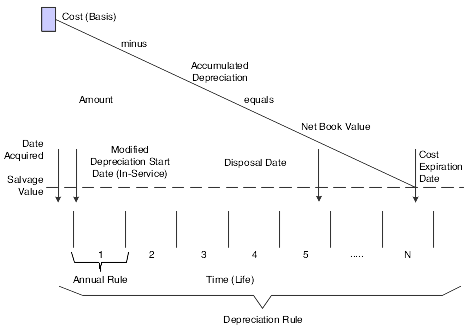Elements of Asset Depreciation
This graphic shows the elements of asset depreciation:

These elements used with depreciation rules control how the system calculates depreciation:
- Cost
Costs can be divided in different ways for different assets according to the nature of the assets, such as buildings, equipment, vehicles, and so on. Cost also occurs for a single asset in multiple books or ledgers for such purposes as financial accounting, consolidated reporting, management and cost accounting, and regulatory purposes.
Cost can affect depreciation in many different ways. For example:
Several elements of asset cost might exist in a single book or ledger
Several elements of cost might exist at one specific time or spread out over time
Cost might exist concurrently in multiple currencies
- Time (life years)
The life of an asset is represented in the depreciation process as a subdivision of time. Different depreciation methods might use different subdivisions of time. For example, the subdivision of time might be:
The same as the fiscal year of the organization
Related to the date when the cost for the asset is incurred
Related to the year of a political or regulatory entity
- Accumulated depreciation
At any time during the life of an asset, the total of all depreciation taken.
- Net book value
At any time during the life of an asset, the current or net book value is equal to the cost minus the accumulated depreciation.
For example, at the beginning of an asset's life, when no depreciation has been taken, the net book value is equal to the original cost. At the end of the asset's life, when all possible depreciation has been taken, the net book value is equal to the salvage value of the asset, if any.
- Salvage value and depreciable basis
At the end of the life of an asset, when it is no longer suitable for use within the organization, residual value might exist. This value, whether it is realized from the market or from scrapping and salvaging, is referred to as the salvage value. Depreciation stops at the salvage value. For example, if the cost of an asset was 1000 USD and the salvage value is 25 USD, accumulated depreciation never goes beyond 975 USD so that there is a residual value of 25 USD. Typically, the amount that is amortized over the life of an asset excludes the salvage value amount.
The salvage value is used in the depreciation process to arrive at the depreciable basis of that asset, or the cost less the salvage value.
- Remaining basis
Remaining basis is the amount to which an asset depreciates in the final year of the asset's life. It is defined as cost minus accumulated depreciation minus salvage value.
- Dates
Depreciation takes place over time. Consequently, many instances occur in the depreciation process in which different dimensions of time (dates) are important. Dates that might especially affect the depreciation process include:
Asset acquisition dates
Depreciation start dates
Asset disposal dates
Cost expiration date
Frequently, depreciation conventions require a modification of one or more of these dates.
- Annual rules
Each year of an asset's life can be subject to different allowances or requirements. For example, the first and last years of an asset's life can be subject to different regulatory requirements.